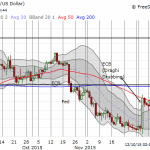
The third estimate of fourth-quarter GDP is 2.9%, up 0.4 percentage points from the second estimate.
The BEA revised its Fourth-Quarter 2017 GDP estimate to 2.9%, topping the consensus estimate of 2.7%.
Rick Davis at the Consumer Metrics Institute provides this summary.
The boost in the headline number resulted from upward revisions to contributions from consumer spending (+0.17%) and inventories (also a +0.17% increase, as a result of reportedly slower inventory contractions). No other line items changed materially.
The BEA’s “bottom line” for the quarter (their “Real Final Sales of Domestic Product”, which excludes inventories) increased to +3.41%, up +0.18% from the previous estimate and +1.04% from the prior quarter.
Real annualized household disposable income decreased -$2 per year from the previous report to $39,223 (in 2009 dollars). The household savings rate deteriorated to 2.6%, lower than the level recorded in third quarter of 2007 — at the onset of the “Great Recession.”
For this revision the BEA assumed an effective annualized deflator of 2.35%. During the same quarter (October 2017 through December 2017) the inflation recorded by the Bureau of Labor Statistics (BLS) in their CPI-U index was a very similar but slightly higher 2.49%. Under estimating inflation results in optimistic growth rates, and if the BEA’s “nominal” data was deflated using CPI-U inflation information the headline growth number would have been slightly lower at a +2.82% annualized growth rate.
What Happened?
Hurricane spending undoubtedly boosted fourth-quarter GDP, and consumers had to tap into saving to buy.
Retail sales have not been good so far in 2018 so expect a snapback in the first quarter.
The GDPNOw Real Final Sales estimates for the first quarter sit at 1.1%.












Leave A Comment